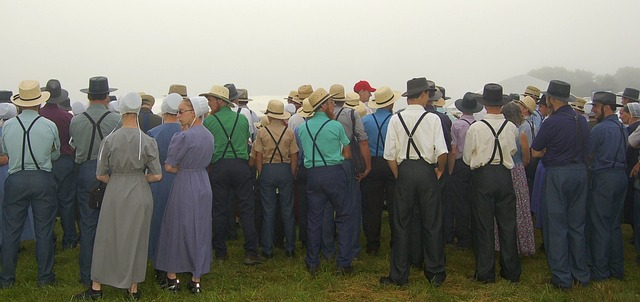The Amish people are a religious group known for their simple and traditional way of life. They live in close-knit communities and adhere to a set of strict religious principles. This introduction provides a brief overview of how Amish people live.
Table of Contents
The Amish Lifestyle: A Closer Look at Simple Living
The Amish lifestyle is often seen as a fascinating and mysterious way of living. With their simple clothing, horse-drawn buggies, and lack of modern technology, the Amish people have managed to maintain a unique and traditional way of life. But how do they actually live? Let’s take a closer look at the Amish lifestyle and explore the principles that guide their simple living.
One of the key aspects of the Amish lifestyle is their commitment to simplicity. The Amish believe in living a life that is free from the distractions and temptations of the modern world. They value hard work, humility, and community above all else. This commitment to simplicity is reflected in their homes, which are typically modest and functional, without any unnecessary luxuries.
The Amish also place a strong emphasis on self-sufficiency. They believe in taking care of themselves and their community, rather than relying on outside sources for their needs. This means that the Amish grow their own food, make their own clothes, and build their own homes. They value manual labor and believe that hard work is a virtue that brings them closer to God.
In addition to simplicity and self-sufficiency, the Amish lifestyle is deeply rooted in their faith. Religion plays a central role in every aspect of their lives. The Amish are devout Christians who follow the teachings of the Bible and strive to live a life that is pleasing to God. They attend church services regularly, and their faith guides their decisions and actions.
Another important aspect of the Amish lifestyle is their strong sense of community. The Amish live in close-knit communities where everyone knows each other and supports one another. They believe in helping their neighbors and working together for the common good. This sense of community is evident in their barn raisings, where the entire community comes together to build a barn for a neighbor in need.
Despite their commitment to simplicity, the Amish are not completely isolated from the outside world. They do interact with non-Amish people, known as “English,” for business and other necessary purposes. However, they are cautious about the influence of the modern world and strive to maintain their distinct way of life.
While the Amish lifestyle may seem challenging to some, it is important to note that the Amish people find great joy and fulfillment in their way of living. They value the simple pleasures of life, such as spending time with family, working the land, and being part of a close-knit community. Their commitment to simplicity and self-sufficiency allows them to focus on what truly matters to them – their faith, their family, and their community.
In conclusion, the Amish lifestyle is a unique and fascinating way of living that is centered around simplicity, self-sufficiency, faith, and community. The Amish people have managed to preserve their traditional way of life in a rapidly changing world. While their lifestyle may seem challenging to some, it brings them great joy and fulfillment. The Amish serve as a reminder that there is beauty in simplicity and that true happiness can be found in the things that truly matter.
Traditional Amish Practices: Exploring Their Unique Beliefs and Customs

The Amish people are known for their unique way of life, which is deeply rooted in their traditional beliefs and customs. Living in close-knit communities, the Amish have managed to preserve their distinct lifestyle for centuries. In this article, we will explore some of the traditional practices that define the Amish way of life.
One of the most striking aspects of Amish life is their rejection of modern technology. The Amish believe that embracing modern conveniences would lead to a loss of community and a weakening of their faith. As a result, they choose to live without electricity, cars, and other modern amenities. Instead, they rely on traditional methods of transportation, such as horse-drawn buggies, and use oil lamps for lighting.
Another important aspect of Amish life is their commitment to simplicity and self-sufficiency. The Amish believe in living a humble and modest life, free from materialistic pursuits. They value hard work and self-reliance, and most Amish families are engaged in farming or other manual labor. This lifestyle allows them to provide for their own needs and minimize their reliance on the outside world.
The Amish also have a strong sense of community and mutual support. They live in close proximity to one another, often in rural areas, and work together to meet the needs of the community. This includes helping each other with farming tasks, building houses, and even providing healthcare. The Amish have their own healthcare system, which is based on the principle of mutual aid. Each family contributes to a fund that covers medical expenses for the entire community.
Religion plays a central role in Amish life. The Amish are a Christian denomination that follows the teachings of Jesus Christ. They believe in living a life of obedience to God and strive to maintain a close relationship with Him. Amish worship services are held in homes or barns, as they do not have formal church buildings. The Amish also practice adult baptism, which is seen as a personal commitment to their faith.
Education is another important aspect of Amish life. The Amish believe in providing their children with a practical education that prepares them for life within the community. Amish schools are typically one-room schoolhouses, where children learn reading, writing, and arithmetic, as well as practical skills like woodworking and sewing. Education beyond the eighth grade is generally discouraged, as it is believed that further education could lead to a departure from Amish values.
Despite their unique way of life, the Amish have managed to coexist with the modern world. They interact with the outside community for business purposes and are known for their high-quality craftsmanship. Many Amish communities have established businesses that produce furniture, quilts, and other handmade goods, which are highly sought after by tourists and locals alike.
In conclusion, the Amish people live a traditional and unique lifestyle that is deeply rooted in their beliefs and customs. Their rejection of modern technology, commitment to simplicity and self-sufficiency, strong sense of community, and religious devotion are all defining aspects of Amish life. Despite their distinct way of life, the Amish have found ways to coexist with the modern world and contribute to society through their craftsmanship and business ventures.
Sustainable Living: How the Amish Embrace Self-Sufficiency
Have you ever wondered how the Amish people live? Their way of life is often seen as a fascinating and unique example of sustainable living. The Amish community embraces self-sufficiency in a way that many of us can only dream of. From their simple homes to their reliance on traditional farming methods, the Amish have found a way to live in harmony with nature while still meeting their basic needs.
One of the key aspects of Amish sustainable living is their commitment to simplicity. Amish homes are typically small and modest, built without the use of modern conveniences such as electricity. Instead, they rely on natural light and wood-burning stoves for warmth and cooking. This not only reduces their environmental impact but also encourages a sense of community, as families spend more time together in shared spaces.
In addition to their simple homes, the Amish also prioritize sustainable agriculture. They believe in working the land by hand, using traditional farming methods that have been passed down through generations. This means no tractors or other heavy machinery. Instead, they rely on horses to plow their fields and cultivate their crops. By avoiding the use of fossil fuels, the Amish reduce their carbon footprint and maintain a closer connection to the land.
Another way the Amish embrace self-sufficiency is through their commitment to growing their own food. Many Amish families have large gardens where they grow a variety of fruits and vegetables. They also raise livestock for meat, milk, and eggs. By producing their own food, the Amish reduce their reliance on industrial agriculture and the transportation of goods. This not only benefits the environment but also allows them to have more control over the quality and safety of the food they consume.
The Amish also prioritize waste reduction and recycling. They believe in using resources wisely and avoiding unnecessary waste. For example, they often repurpose or repair items instead of buying new ones. This not only reduces their consumption but also saves money. Additionally, the Amish are known for their craftsmanship and skill in making handmade goods. By valuing quality over quantity, they create products that are built to last, reducing the need for constant replacement.
One of the most striking aspects of Amish sustainable living is their reliance on community support. The Amish believe in helping one another and working together for the benefit of the entire community. This is evident in their barn raisings, where the entire community comes together to build a new barn for a neighbor. By pooling their resources and skills, the Amish are able to accomplish tasks that would be difficult for an individual or even a small group. This sense of community not only strengthens social bonds but also reduces the need for excessive consumption.
In conclusion, the Amish people have found a way to live sustainably by embracing self-sufficiency. Through their commitment to simplicity, sustainable agriculture, growing their own food, waste reduction, and community support, the Amish have created a lifestyle that is in harmony with nature and promotes a sense of community. Their way of life serves as an inspiration for those of us seeking to live more sustainably and in balance with the world around us.
Amish Community Life: Understanding the Importance of Strong Social Bonds
The Amish community is known for its unique way of life, which is deeply rooted in tradition and strong social bonds. Understanding how Amish people live requires a closer look at the importance they place on community and the ways in which they foster these strong social connections.
One of the key aspects of Amish community life is the emphasis on working together. Amish families often live and work on farms, where everyone contributes to the daily tasks. From tending to the animals to planting and harvesting crops, each member of the family has a role to play. This shared responsibility not only helps to ensure the success of the farm but also strengthens the bonds between family members.
In addition to working together on the farm, Amish community members also come together for various other activities. One such activity is the barn raising, where the entire community gathers to help construct a new barn for a family in need. This tradition not only showcases the community’s willingness to lend a helping hand but also serves as a way to strengthen the social fabric of the community.
Another important aspect of Amish community life is the practice of mutual aid. When a member of the community is facing a difficult time, whether it be due to illness, financial hardship, or other challenges, the community rallies together to provide support. This can come in the form of financial assistance, help with household chores, or simply offering a listening ear. The Amish believe in the importance of taking care of one another, and this sense of mutual aid is a cornerstone of their community life.
Religion also plays a central role in Amish community life. The Amish are a deeply religious group, and their faith is woven into every aspect of their daily lives. Church services are held every other Sunday, and the entire community comes together to worship and reflect on their beliefs. These services provide an opportunity for community members to connect with one another on a spiritual level and reinforce the shared values that bind them together.
Social gatherings are another important part of Amish community life. From weddings to birthday parties, these events provide an opportunity for community members to come together and celebrate. These gatherings often involve traditional Amish food, music, and games, creating a sense of joy and camaraderie among those in attendance. These social events not only serve as a way to strengthen existing social bonds but also provide an opportunity for young people to meet potential partners within the community.
In conclusion, Amish community life is characterized by strong social bonds and a deep sense of togetherness. From working together on the farm to coming together for mutual aid and social gatherings, the Amish place a high value on community and the connections that bind them together. By understanding the importance of these social bonds, we can gain a greater appreciation for the unique way of life that the Amish lead.
Conclusion
In conclusion, Amish people live a simple and traditional lifestyle that emphasizes community, faith, and self-sufficiency. They reject modern technology and conveniences, opting for manual labor and traditional practices. Their daily lives revolve around farming, family, and religious activities, with a strong emphasis on maintaining their distinct cultural identity. Despite living in a rapidly changing world, the Amish continue to prioritize their values and maintain a unique way of life.
For licensing reasons, we must provide the following notice: This content was created in part with the help of an AI.


